Záznam přednášky Paoly Lucero z letošního HPST semináře Novinky a trendy (nejen) Agilent Technologies na téma využití pyrolýzy ve spojení s GC/MSD pro analýzu předmětů a děl našeho kulturní dědictví.
Záznam přednášky ZDE.
With the exception of fresco technique, all painting techniques involve the utilization of an organic binder to apply the pigments and create the pictorial layer(s).
Over the centuries, the natural organic materials that have been used by occidental artist are: proteinaceous materials (egg, animal glue and casein or milk), polysaccharide gums (arabic, tragacanth and fruit tree gums), drying oils (linseed, walnut and poppy seed oils), natural resins and beeswax.
Most of these materials are characterized by a macromolecular structure: proteins and plant gums are natural polymers while natural resins and drying oils undergo cross-linking reactions as a result of curing process which involve their exposure to light and air.
In addition to natural materials, synthetic polymers can be present in works of art as restoration materials and even paint binders such as alkyd resins and acrylic water dispersions.
Due to their macromolecular nature, analytical pyrolysis is a fast and efficient approach for identifying such organic materials in samples from works of art. This conference will present the results of the analysis of mural paintings from Bečov Castle in Czech Republic and polychromies form Orte, Lecce in Italy, using and Py GC-MS with thermally assisted sylilation.
Motivation for the analysis of art materials
Art material analysis important in order to
- Better understand the Master’s technique her/his artistic socio cultural, economic background, and the resources and materials available to him
- Identify any alterations, modifications or later conservative intervention
- Assess the authenticity of a particular piece of art
- Reveal potential changes of the materials used by the artist over time, or under the influence of light and environmental conditions
Organic materials in art objects
Different binder reveal different painting technique
- Encaustic painting: wax
- Oil paint: siccative oil (mainly linseed oil)
- Tempera painting: based on a proteinaceous component (gelatin animal glue, casein, or mixture of these) lipid additives, as siccative oils (if present in higher amounts the technique is called tempera grassa)
- Aquarelle painting: mainly arabic gum
- Modern painting: synthetic resins
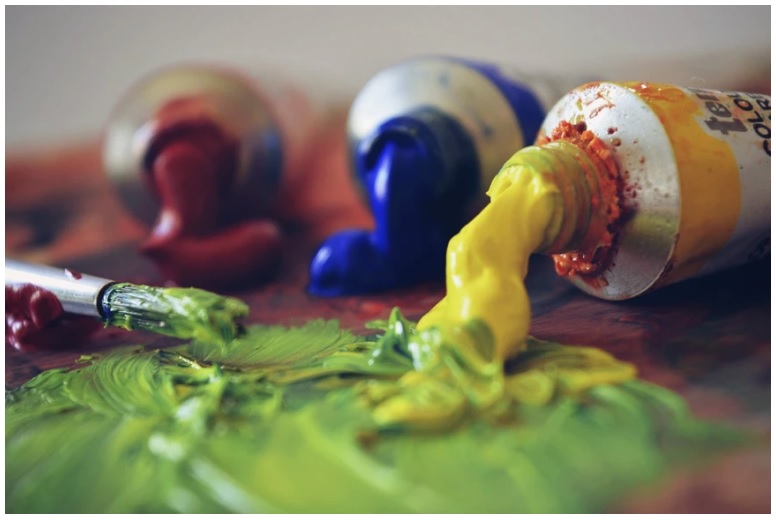
Pixabay/Henrieta Ondrejková: Organic materials in art objects
Challenges in the analysis of organic paint constituents
Critical consideration of the following factors necessary when planning an analytical investigation
- Several organic natural and synthetic substances are often simultaneously present in the layered structure
- Non original compounds, formed as a result of aging or introduced by restoration treatments and pollution, are generally also present
- A very low amount of organic matter (a few percent in the overall weight or even lower) is generally encountered in a minute heterogeneous paint sample (<<1 mg)
Organic materials in art objects
- Binders if used as a matrix of the paint
- Varnishes if applied as a protective layer
- Consolidants if used for the conservation of a fragile paint (=> can complicate the understanding of the original painting technique !)

Organic materials in art objects
Organic materials used in artworks
- Proteins
- Glycerolipids
- Waxes
- Natural resins
- **Polysaccharide materials
- Bituminous materials
- Organic dyes
- Synthetic polymers
these materials are characterized by a macromolecular nature in some cases they are natural polymers, others undergo oligomerization or cross linking reactions as an effect of exposure to light and air Due to their macromolecular nature, analytical pyrolysis is a fast and efficient approach for identifying such organic materials in samples from works of art.
- Natural polymers
- Undergo polymerization
Materials and Methods
The instrumentation consisted of a micro-furnace Multi-Shot Pyrolyzer EGA/Py-3030D (Frontier Lab, Japan) connected to an Agilent gas chromatograph 8890 and a single quadrupole MSD Agilent 5977B.
This technique was selected due to its minimum sample size and pre-treatment requirements.
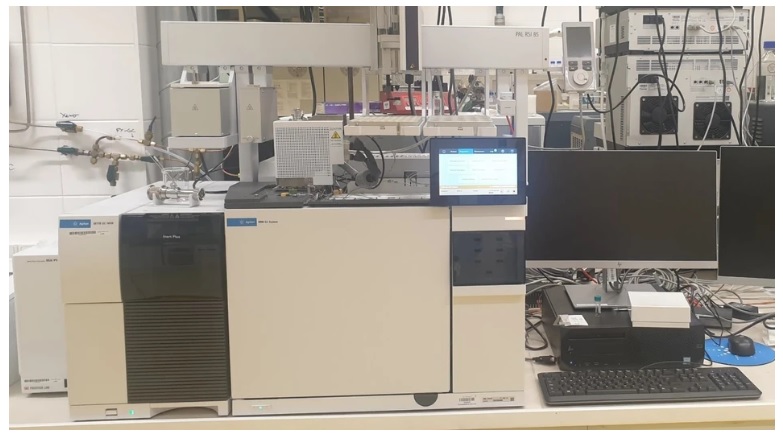
HPST/UPOL: Py-GC/MSD system Frontier Lab Multi-Shot Pyrolyzer EGA/Py-3030D and Agilent GC 8890 + MSD Agilent 5977B
Single shot pyrolysis was used, pyrolysis conditions were optimized as follows pyrolysis chamber temperature 550 °C, time: 1 min, T interface 280 °C The GC injector Temperature was 280 °C The GC injection port was operated in split mode with a split ratio of 1:10
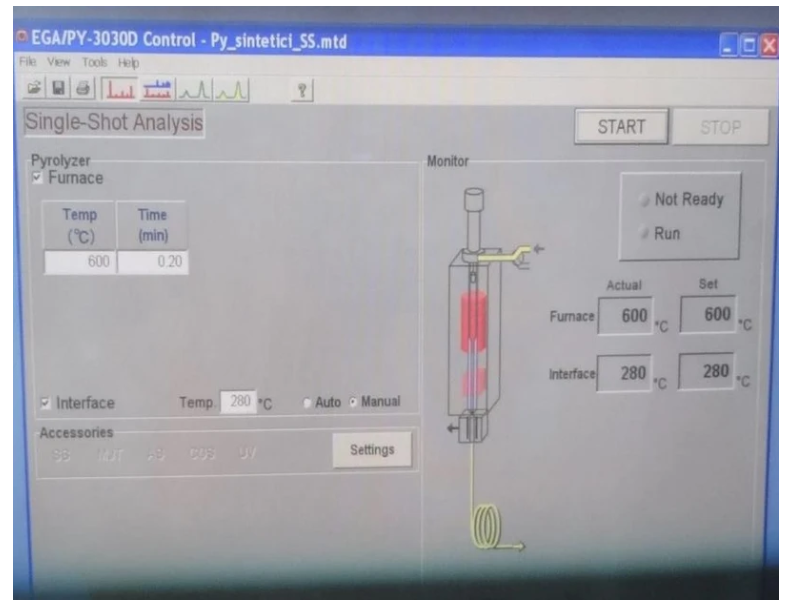
Single shot pyrolysis Pyrolyzer EGA/Py-3030D
MSD ChemStation (Agilent Technologies) software was used for data analysis, and peak assignment was based on a comparison with mass spectra libraries (NIST)
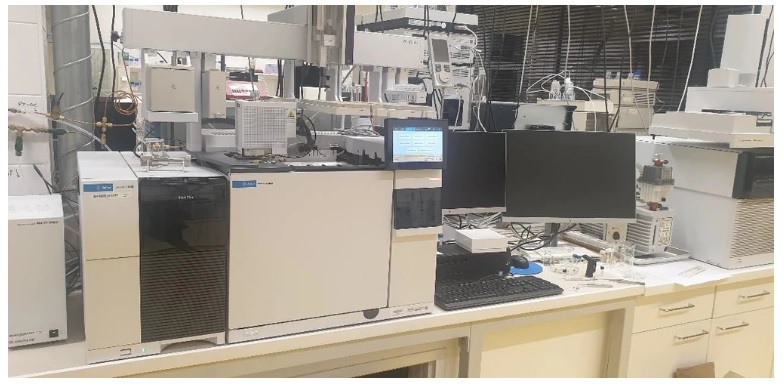
Agilent chromatograph 8890 and a single quadrupole MSD Agilent 5977B
Sample preparation and Pyrolysis Conditions
The samples (~0.2 mg) were placed in platinum sample cups and then derivatized with 5 μl of HMDS.
The cups were placed on top of the pyrolyzer at ambient temperature and then placed into the furnace.
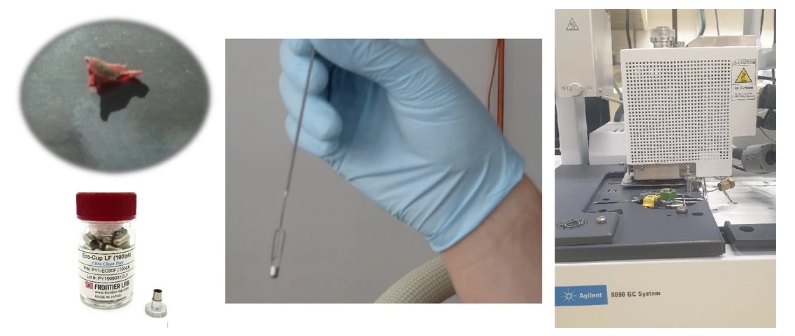
HPST/UPOL: Sample preparation for Pyrolysis GCMS analysis
Py/GC-MS Application
Case Studies Wall painting 16th Century
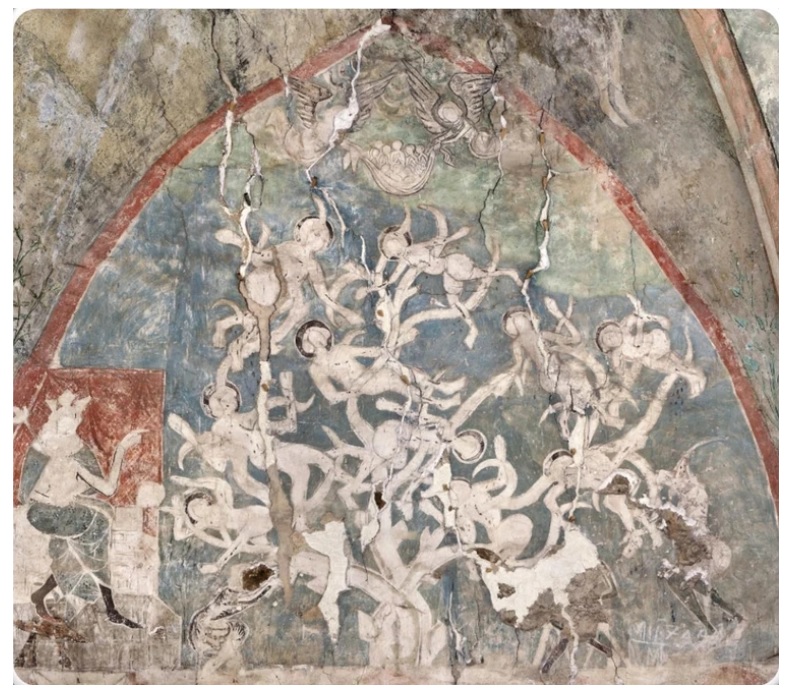
HPST/UPOL: Py-GC/MS Application - Case Studies Wall painting 16th Century
- Proteinaceous tempera
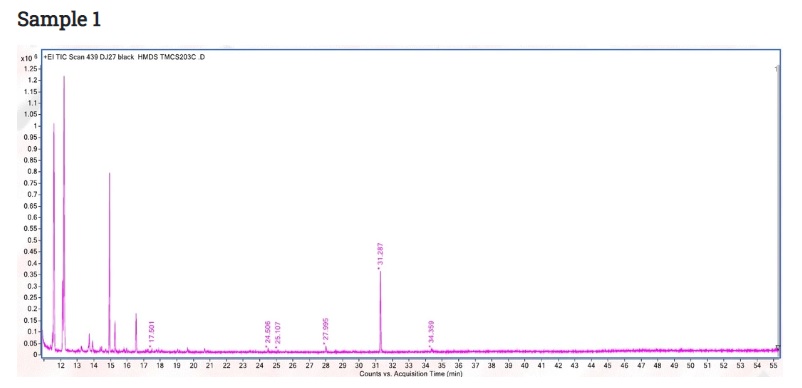
HPST/UPOL: Py-GC/MS analysis of Proteinaceous tempera (Sample 1)
No Ret / Time / Compound
- 3 / 17.5 / Glycerol
- 8 / 24.5 / Octadecanoic acid
- 10 / 27.9 / Tetradecanoic acid
- 11 / 31.3 / Hexadecanoic acid
- 12 / 34.3 / Stearic acid
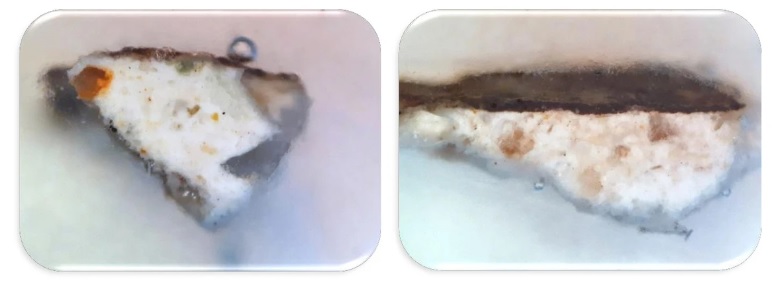
HPST/UPOL: Proteinaceous tempera Sample 1 and Sample 2
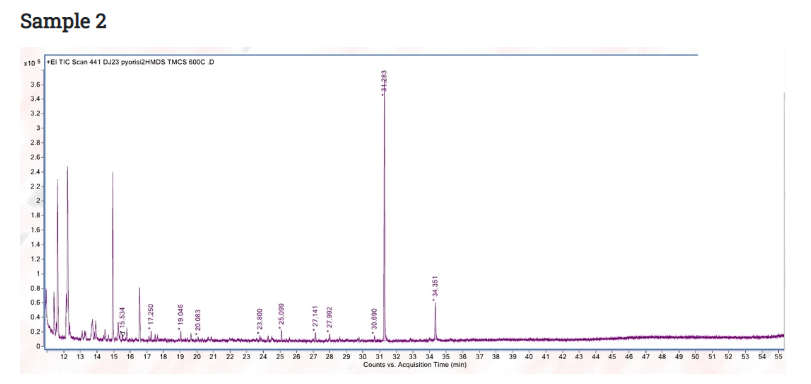
HPST: UPOL: Py-GC/MS analysis of Proteinaceous tempera (Sample 2)
No Ret / Time / Compound
- 1 / 15.5 / Heptanoic acid
- 2 / 17.2 / Octanoic acid
- 3 / 17.5 / Glycerol
- 4 / 17.6 / Silanol, trimethyl-, phosphate (3:1)
- 5 / 19 / Nonanoic acid
- 6 / 23.8 / Silane, (1,2,3-benzenetriyltris(oxy))tris(trimethyl-
- 7 / 24.5 / Octadecanoic acid
- 8 / 27.1 / Azelaic acid
- 9 / 27.9 / Tetradecanoic acid
- 10 / 31.3 / Hexadecanoic acid
- 11 / 34.3 / Stearic acid
Case Studies Orte polychrome objects
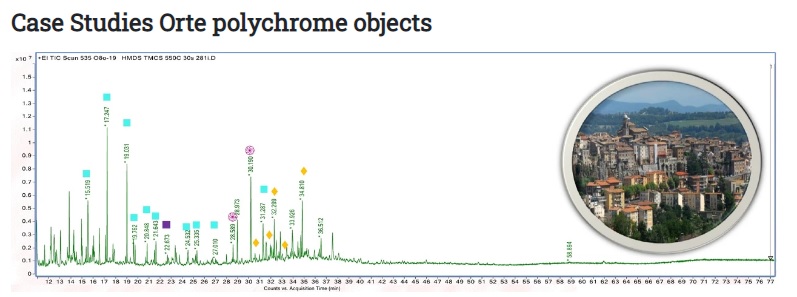
HPST/UPOL: Py-GC/MS analysis of Orte Polychrome objects
No Ret / Time / Compound
- 1 / 15.5 / heptanoic acid ■
- 2 / 17.2 / octanoic acid ■
- 3 / 19.0 / nonanoic acid ■
- 4 / 20.8 / decanoic acid ■
- 5 / 21.69 / pentadecane
- 6 / 22.6 / undecenoic acid ■
- 7 / 24.5 / dodecanoic acid ■
- 8 / 25.3 / octanedioc acid ■
- 9 / 27.1 / nonadioic acid ■ (azelaic)
- 10 / 28.5 / phtalic acid deriv ֍
- 11 / 30.2 / dibutyl phthalate ֍
- 12 / 30.9 / dehydroabietic acid ♦
- 13 / 31.3 / hexadecanoic acid ■ (palmitic)
- 14 / 31.5 / pimaric acid ♦
- 15 / 32.2 / phenanthrene,2,7-dimethyl ♦
- 16 / 32.8 / 10,18-Bisnorabieta-5,7,9(10),11,13-pentaene ♦
- 17 / 34.8 / phenanthrene, 1-methyl-7-(1-methylethyl)- ♦
Diterpenic molecules in resins from conifer plants order
Abietane squeleton
- Abietic acid
- Dehydroabietic acid
- 7-oxodehydroabietic acid
Pimarane squeleton
- Pimaric acid
- Isopimaric acid
- Sandaracopimaric acid
Conclusions
Py-GC/MS is rapid, avoids sample wet chemical workup, avoiding sample loss and contamination, and has a low sample requirement.
It allows the determination, in a single step, of polymeric materials and low molecular weight components. Pyrolysis is a relatively inexpensive technique, especially if compared with the classical wet analytical procedures that are required prior to GC/MS analyses.
Py-GC/MS technique overcomes the major disadvantages encountered in GC/MS, i.e. undetectability of synthetic polymers and unpredictable interferences

HPST:UPOL: Py-GC/MS analysis of organic binders in Cultural Heritage
Zdroj
Článek publikován také na LabRulez.




